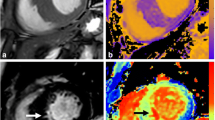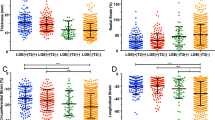Abstract
Aim of the present study was to investigate the relations between myocardial mechanics and the extent of hypertrophy and fibrosis in hypertrophic cardiomyopathy (HCM). Forty-five consecutive patients with HCM and 15 subjects without structural heart disease were included. Cardiac magnetic resonance with late gadolinium enhancement (LGE) imaging was performed to evaluate biventricular function, LV mass index and presence/extent of LGE, expression of replacement fibrosis. Myocardial T1 relaxation, a surrogate of interstitial fibrosis, was measured from Look-Locker sequence. Feature-tracking analysis was applied to LV basal, mid and apical short-axis images to assess systolic and diastolic global LV circumferential strain (CS) and strain rate (CSr). Peak systolic CS and CSr were significantly higher among HCM patients as compared to control subjects (p = 0.015 and p = 0.007, respectively). The ratio of peak CSr during early filling to peak systolic CSr was significantly lower among HCM patients (p = 0.002). At multivariate linear regression analysis, LV mass index (p < 0.001) and %LV LGE (p = 0.011) were significantly and independently related to peak systolic CS; LV mass index (p < 0.001) and %LV LGE (p = 0.023) were significantly and independently related to peak systolic CSr; %LV LGE (p = 0.021) and T1 ratio (p = 0.006) were significantly and independently related to the ratio of peak CSr during early filling to peak systolic CSr. LV systolic mechanics are enhanced and LV diastolic mechanics are impaired in HCM. Extent of hypertrophy and replacement fibrosis influence the LV systolic mechanics while extent of replacement fibrosis and interstitial fibrosis influence the LV diastolic mechanics.



Similar content being viewed by others
References
Gersh BJ, Maron BJ, Bonow RO et al (2011) 2011 ACCF/AHA guideline for the diagnosis and treatment of hypertrophic cardiomyopathy: a report of the American College of Cardiology Foundation/American Heart Association Task Force on Practice Guidelines. Circulation 124:e783–831
Elliott PM, Anastasakis A, Borger MA et al (2014) 2014 ESC Guidelines on diagnosis and management of hypertrophic cardiomyopathy: the task force for the diagnosis and management of hypertrophic cardiomyopathy of the European Society of Cardiology (ESC). Eur Heart J 35:2733–2779
Chen X, Zhao T, Lu M et al (2014) The relationship between electrocardiographic changes and CMR features in asymptomatic or mildly symptomatic patients with hypertrophic cardiomyopathy. Int J Cardiovasc Imaging 30(Suppl 1):55–63
Ennis DB, Epstein FH, Kellman P et al (2003) Assessment of regional systolic and diastolic dysfunction in familial hypertrophic cardiomyopathy using MR tagging. Magn Reson Med 50:638–642
Serri K, Reant P, Lafitte M et al (2006) Global and regional myocardial function quantification by two-dimensional strain: application in hypertrophic cardiomyopathy. J Am Coll Cardiol 47:1175–1181
Carasso S, Yang H, Woo A et al (2008) Systolic myocardial mechanics in hypertrophic cardiomyopathy: novel concepts and implications for clinical status. J Am Soc Echocardiogr 21:675–683
Wang J, Buergler JM, Veerasamy K, Ashton YP, Nagueh SF (2009) Delayed untwisting: the mechanistic link between dynamic obstruction and exercise tolerance in patients with hypertrophic obstructive cardiomyopathy. J Am Coll Cardiol 54:1326–1334
Carasso S, Yang H, Woo A et al (2010) Diastolic myocardial mechanics in hypertrophic cardiomyopathy. J Am Soc Echocardiogr 23:164–171
Yang H, Carasso S, Woo A et al (2010) Hypertrophy pattern and regional myocardial mechanics are related in septal and apical hypertrophic cardiomyopathy. J Am Soc Echocardiogr 23:1081–1089
Abozguia K, Nallur-Shivu G, Phan TT et al (2010) Left ventricular strain and untwist in hypertrophic cardiomyopathy: relation to exercise capacity. Am Heart J 159:825–832
Pacileo G, Baldini L, Limongelli G et al (2011) Prolonged left ventricular twist in cardiomyopathies: a potential link between systolic and diastolic dysfunction. Eur J Echocardiogr 12:841–849
Soullier C, Obert P, Doucende G et al (2012) Exercise response in hypertrophic cardiomyopathy: blunted left ventricular deformational and twisting reserve with altered systolic-diastolic coupling. Circ Cardiovasc Imaging 5:324–332
Urbano-Moral JA, Rowin EJ, Maron MS, Crean A, Pandian NG (2014) Investigation of global and regional myocardial mechanics with 3-dimensional speckle tracking echocardiography and relations to hypertrophy and fibrosis in hypertrophic cardiomyopathy. Circ Cardiovasc Imaging 7:11–19
Bogaert J, Olivotto I (2014) MR imaging in hypertrophic cardiomyopathy: from magnet to bedside. Radiology 273:329–348
Augustine D, Lewandowski AJ, Lazdam M et al (2013) Global and regional left ventricular myocardial deformation measures by magnetic resonance feature tracking in healthy volunteers: comparison with tagging and relevance of gender. J Cardiovasc Magn Reson 15:8
Nucifora G, Muser D, Morocutti G et al (2014) Disease-specific differences of left ventricular rotational mechanics between cardiac amyloidosis and hypertrophic cardiomyopathy. Am J Physiol Heart Circ Physiol 307:H680–688
Nacif MS, Turkbey EB, Gai N et al (2011) Myocardial T1 mapping with MRI: comparison of Look-Locker and MOLLI sequences. J Magn Reson Imaging 34:1367–1373
Sibley CT, Noureldin RA, Gai N et al (2012) T1 Mapping in cardiomyopathy at cardiac MR: comparison with endomyocardial biopsy. Radiology 265:724–732
Sechtem U, Pflugfelder PW, Gould RG, Cassidy MM, Higgins CB (1987) Measurement of right and left ventricular volumes in healthy individuals with cine MR imaging. Radiology 163:697–702
Kawel N, Turkbey EB, Carr JJ et al (2012) Normal left ventricular myocardial thickness for middle-aged and older subjects with steady-state free precession cardiac magnetic resonance: the multi-ethnic study of atherosclerosis. Circ Cardiovasc Imaging 5:500–508
Lever HM, Karam RF, Currie PJ, Healy BP (1989) Hypertrophic cardiomyopathy in the elderly. Distinctions from the young based on cardiac shape. Circulation 79:580–589
Harrigan CJ, Peters DC, Gibson CM et al (2011) Hypertrophic cardiomyopathy: quantification of late gadolinium enhancement with contrast-enhanced cardiovascular MR imaging. Radiology 258:128–133
Iles LM, Ellims AH, Llewellyn H et al (2015) Histological validation of cardiac magnetic resonance analysis of regional and diffuse interstitial myocardial fibrosis. Eur Heart J Cardiovasc Imaging 16:14–22
Messroghli DR, Rudolph A, Abdel-Aty H et al (2010) An open-source software tool for the generation of relaxation time maps in magnetic resonance imaging. BMC Med Imaging 10:16
Choi EY, Hwang SH, Yoon YW et al (2013) Correction with blood T1 is essential when measuring post-contrast myocardial T1 value in patients with acute myocardial infarction. J Cardiovasc Magn Reson 15:11
Kobayashi T, Dhillon A, Popovic Z et al (2014) Differences in global and regional left ventricular myocardial mechanics in various morphologic subtypes of patients with obstructive hypertrophic cardiomyopathy referred for ventricular septal myotomy/myectomy. Am J Cardiol 113:1879–1885
Partridge JB, Smerup MH, Petersen SE, Niederer PF, Anderson RH (2014) Linking left ventricular function and mural architecture: what does the clinician need to know? Heart 100:1289–1298
Motoyasu M, Kurita T, Onishi K et al (2008) Correlation between late gadolinium enhancement and diastolic function in hypertrophic cardiomyopathy assessed by magnetic resonance imaging. Circ J 72:378–383
Moreo A, Ambrosio G, De Chiara B et al (2009) Influence of myocardial fibrosis on left ventricular diastolic function: noninvasive assessment by cardiac magnetic resonance and echo. Circ Cardiovasc Imaging 2:437–443
Ellims AH, Iles LM, Ling LH et al (2012) Diffuse myocardial fibrosis in hypertrophic cardiomyopathy can be identified by cardiovascular magnetic resonance, and is associated with left ventricular diastolic dysfunction. J Cardiovasc Magn Reson 14:76
Fang L, Beale A, Ellims AH et al (2013) Associations between fibrocytes and postcontrast myocardial T1 times in hypertrophic cardiomyopathy. J Am Heart Assoc 2:e000270
Gai N, Turkbey EB, Nazarian S et al (2011) T1 mapping of the gadolinium-enhanced myocardium: adjustment for factors affecting interpatient comparison. Magn Reson Med 65:1407–1415
Author information
Authors and Affiliations
Corresponding author
Ethics declarations
Conflict of interest
No conflicts of interest, financial or otherwise, are declared by the authors.
Rights and permissions
About this article
Cite this article
Nucifora, G., Muser, D., Gianfagna, P. et al. Systolic and diastolic myocardial mechanics in hypertrophic cardiomyopathy and their link to the extent of hypertrophy, replacement fibrosis and interstitial fibrosis. Int J Cardiovasc Imaging 31, 1603–1610 (2015). https://doi.org/10.1007/s10554-015-0720-0
Received:
Accepted:
Published:
Issue Date:
DOI: https://doi.org/10.1007/s10554-015-0720-0




